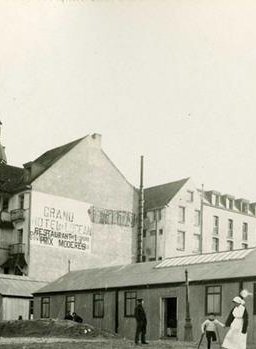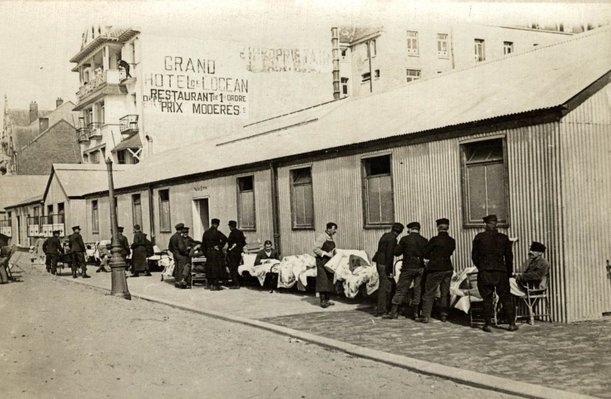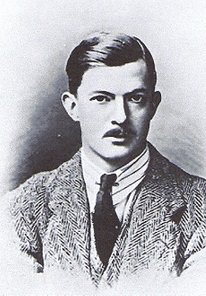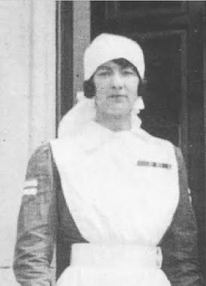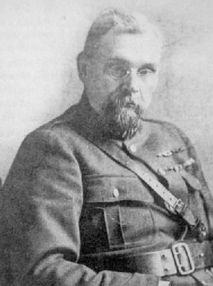MAJOR GORDONS INVOLVEMENT IN ESTABLISHING THE HOSPITAL L'OCEAN AT LA PANNE
ORIGINS
Hotel L'Ocean was a summer vacation hotel build in 1904, with four floors and 37 beds. It was owned by family Huysseune in La Panne.
THE OUTBREAK OF THE WAR
Queen Elisabeth was the founder of the military Hospital in 1914 and had previously given a wing in the Royal Villas for the wounded. Because of the increase of casualties, a new location had to be found and she commandeered the Hotel L'ocean for her new hospital. One of the major founders was Doctor Le Page, who turned the hotel, under the supervision of Queen Elisabeth to a Red Cross hospital. The financial support was given as a task to Major Gordon, and the hospital was mostly funded by British gifts. The Belgian army delivered for the staff and needed vehicles. A second task for Major Gordon was to buy most of the equipment in London because the Queen always wanted to use the best materials. Because of Dr Depage's relationships, the hospital was well supported by high standing personnel. This was ... for the staff of the 'Service de Santé' of the Belgian Military under command of General-Doctor Melis. On many occasions had the Royal family to interfere with both doctors. Doctor Depage, who was a Colonel-Doctor, surrounded himself with a permanent team. He chose his doctors from the mobilised Belgian troops. The nursery was occupied by a woman from the nursery schools from England, Canada, US and Denmark. The entire personnel was housed in some twenty villas in the nearby area. The hotel had some 100 chambers over 5 floors, and the hospital was provided with some 200 beds but could be extended to 2.000. The hospital had two operation rooms, this was done to aid the heavily wounded, that was brought in by the Red Cross at once and decrease the deathly casualties. Many of the personal where a specialist's in skull, chest, abdomen, fractures, etc. There was also a dentist and biomedical laboratory.
Early in 1915, de hospital expended with wooden barracks around the hotel. The first pavilion housed 100 beds and was called the British Pavillon, the second housed 240 beds and was called Pavillon Everyman), the birth housed 300 beds and was named after the King and Queen (Albert-Elisabeth), this pavilion was destroyed in the same year by fire. The fourth and last one housed only 40 beds and was made to receive the freshly wounded.
THE BELGIAN RED CROSS
On 5 March 1915, an article was published that the Belgian Red Cross society was created:
Sir,- We beg to advise you that the Belgian Red Cross was created, under the patronage of H.M. the Queen of the Belgians, an Anglo-Belgian Committee, in order to represent officially the interest of the Belgian Red Cross, to the exclusion of any other organisation or person, throughout England. The members of the Anglo-Belgian Committee are - President Baron C. Goffinet, Plenipotentiary Minister, Vice President of the Belgian Red Cross Members: The Earl Curzon of Kedleston; Major A. A. Gordon; The Honourable Arthur Stanley (MP), President of the Joint Committee of the British Red Cross and St. John Ambulance; Paul Hymans, Minister of State for Belgium. Hon. Secretary: Louis Lasard - Judge at the Brussels Court of Commerce.
Kindly note that all communications concerning the Belgian Red Cross are to be addressed to the Anglo-Belgian Committee, at their offices, Savoy Hotel, London, W.C.
We are, dear sir,
yours faithfully
Baron C. Goffinet - President
Louis Lazard - Hon. Secretary
THE BRITISH MISSION
On 23 April 1916, a statement was published in the Sunday Mission about an account that occurred in the Hospital at La Panne.
One day Prince Alexander of Teck presented himself at the hospital with a brother officer, who told the nurse at the door that they came from the British Mission. "Oh!" called out the nurse to the matron, "there are two young men here from the Y.M.C.A."! When the King of the Belgians paid a visit to the hospital at La Panne all British nurses referred to him as "Our King" and he returned the compliment by telling the matron that "British nurses were the best in the world." The King made all the nurses gifts of chocolates.
THE TRAGEDY OF JOHN AIDEN LIDDELL VC
On 31 July 1915, in the region of Ostend-Brugge-Gent, a British plane was flying against a blue cobalt sky for reconnaissance of the German transport roads and movement. The Germans who were preparing for a British invasion had brought in thousands of German workers, troops and naval warfare material didn't appreciate the presence of the enemy aeroplane and opened with all the anti-aircraft guns they had placed in a battery in miles around. The plane was seen single-handedly turning, twisted and diving from the fierce flame-grey shells that was only protected by Divine provenance. All of a sudden
the aeroplane was masked by an ominous grey shell burst. Tumbling, turning, twisting,
plunging headlong like a stone, it swept down into view below. The German guns stopped firing and all the soldiers watched and waited for the moment of impact. Exultance, however, robbed the German gunners from their customary caution, when the aeroplane snatched of the very jaws of death and the Germans astonished what just had happened opened fire again after a brief moment.
The aeroplane was flown by John Aiden Liddell and his observer. The two men had given the task of frustrating the German invasion of Britain. When both men were halfway on the reconnaissance, they found themselves between Ostend and Bruges - Twenty miles across the lines - one a shrapnel shell burst violently against the side of the aeroplane, badly smashing the control wheel and throttle control and shattering his right thigh. His companion later describes that Liddell at that point had lost consciousness and that the plane pitched down giddily in a headlong dive of 3000 feet. Only the upward rush of air from that desperate plunge served to bring Liddell back to conscious from his death-like faint and then he recovered himself only by an almost superhuman effort. Weak and exhausted by the sudden loss of blood, suffering excruciating agonies from the gaping wound in his side; and fired at incessantly from all side, he stood that terrible strain. He was determined to prevent his observer from being taken prisoner and the valuable information which they had gleaned falling into the enemy's hands. Eventually, he landed his aeroplane will within the British lines, half an hour after he had been wounded, as deftly and as neatly as returning from a normal flight. He was carried immediately to the neighbouring hospital of La Panne. He was put in the care of Mrs Fenwick and his observer Mr Peck accompanied him. On 13 August 1915, Mrs Fenwick states in her diary that Captain Liddell's leg is doing badly and will have to be cut off after all, but we still hope not. Three days later she said that Liddell isn't doing well. On 17 August the decision was made to amputate his leg of the day after. In the afternoon, Prince Alexander of Teck entered the hospital and informed him that he would be awarded the Victoria Cross, which made him so happy. Two days later, Mrs Fenwick wrote in her diary, that Liddell's leg was amputated but that he had blood-poisoning all over his body and that she feared for his life. On 21 August 1915, the British mission wired for his mother and she crossed the channel to be with her son. During these days Major A. A. Gordon had visited his fellow Scotsman Liddell many times and in the final days of his life, he asked he would like something from London because he was heading in a few days. Liddell asked a dozen bottles of Perrier water and Major Gordon sent it as soon as he arrived in London. Captain John A. Liddell, unfortunately, died on 31 August 1915. Only two days later, the package with the water bottles would arrive in the hospital.
John A. Liddell had a quiet undemonstrative youth and was a shy boy who was the last man anyone would ever consider to be so brave and gallantry. He was one of those rare characters which chose to give rather than to ask, and in the giving knew neither fear nor despair. After his death, his mother brought his body back to Britain and buried him at The Holy Ghost Cemetery in Basingstoke, where he still rests today. His sister Dorothy, travelled soon afterwards to La Panne to volunteer in the hospital where her brother died, she worked there till the end of the war.
DOROTHY LIDDELL
Dorothy Liddell was the sister of Victoria Cross winner John Aidan Liddell who died at La Panne. Dorothy worked after her brothers death in the hospital L'ocean till the end of the war, urning her the M.B.E. Her lifetime ambition was to became an archaelogist and she had the opportunity to be part of the excavation at Windmill Hill, Avebury from 1925 till 1929.
Alexander Keiller, a scottish archaeologist, dedacted the museum, that was erected in his name to Dorothy Liddell, short after her death in 1938.
THE TRAGEDY OF MARIE PICARD
Marie Picard was born in 1872 at Elsene, Belgium, as the daughter of Engineer Emil Picard and Victorine Héger. Marie met Antoine Depage, because of her uncle, who was a medical Tudor in the University of Brussels. The couple later married in 1893 and had three sons.
In 1903 established Marie and her husband the surgical institute at Berkendael. The institute laid the basis to the first Belgian medical school in 1907, which was let by the later martyr Edith Cavell.
During the Balkan war, Picard left with a medical unit and served in the hospital Tach Kicha in Constantinopel. Her oldest son served also with a field ambulance.
At the outbreak of the war, Dr Depage en Marie Picard established a military hospital at the Belgian Royal Palace. Later the couple will establish two more hospitals in Calais, where the Belgian medical units where situated. After the German were halted at the Yser, Queen Elisabeth asked the couple if they would establish a military hospital at the L'ocean hotel in La Panne. Dr Depage and Marie Picard worked close together with Major Gordon to get supplies in London. Marie Picard, later left to America for the funding of the hospital and achieved in getting a substantial amount of money. She returned in May 1915 with the Lusitania to Europa. The ship was later hit by a German torpedo. Marie Picard, together with doctor James Houghton aided the passengers into the lifeboats and nursed wounded sailors and the boxer Matt Freeman. When the water reached the upper deck, she jumped in the water, but got stuck in a net and drowned. Her body was brought back to La Panne where she was buried in dunes until she was reburied in 1920 at the cemetery of Bosvoorde.
DR ANTOINE DEPAGE
Antoine Depage was born in 1862 at Bosvoorde, Belgium. He grew up in a family of local notables who were active in the agriculture and merchants. His school studies were not magnificant and teachers call him a undisciplined student. After his (difficult) graduation, he choice to work on his parents farm, but this was whitout consent of the family Solvay, who were neighbourgs of the Depage family. They encourage him to go to the university, and he choice to take courses in medicine, because the entery money was the lowest in this courses. In 1887, in his own surpise, he graduated as a doctor.
THE BAND OF YSÄYE PLAYS FOR THE WOUNDED
The next morning Major Gordon told us to pack for playing at a Hospital. The scene (at the hospital) was looking like a city of death, with the inexhaustive sounds of the canons at Ypres. Just before we wanted to set down for lunch, a terrible explosion occurred and Ysäye exclaimed "Voila, du sonnette du repas !" witch translates "Voila, the bell for the meal". - Lionel Tardis

